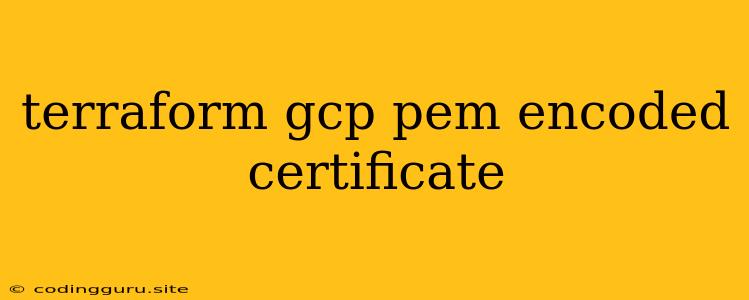Securing Your GCP Resources with Terraform: Using PEM Encoded Certificates
In the realm of cloud infrastructure, security is paramount. Google Cloud Platform (GCP) offers a robust set of tools and services to ensure the safety and integrity of your resources. One crucial element in achieving this security is the use of certificates, and specifically, PEM encoded certificates.
What are PEM Encoded Certificates?
A PEM encoded certificate is a text-based representation of a digital certificate, which contains information about the certificate's issuer, subject, validity period, and public key. This format is widely used in various applications, including securing websites (HTTPS), API connections, and internal communication within a network.
Terraform: The Infrastructure as Code Solution
Terraform is a popular open-source infrastructure as code tool that allows you to define and manage your GCP resources using a declarative language. This approach eliminates manual configuration errors, improves consistency, and enables version control for your infrastructure.
Integrating PEM Encoded Certificates into Your GCP Infrastructure with Terraform
The combination of Terraform and PEM encoded certificates offers a powerful solution for securely managing your GCP resources. Let's delve into how to implement this:
1. Generating Your PEM Encoded Certificate:
- Use a Certificate Authority (CA) or a tool like OpenSSL to generate your certificate.
- Ensure that the certificate is in PEM format and contains both the certificate and the private key.
2. Storing Your Certificate Securely:
- Do not store your PEM encoded certificate directly in your Terraform code. Instead, use a secure secret management service like Google Secret Manager.
- This approach ensures that sensitive information remains protected and is not accidentally exposed in your code repository.
3. Utilizing the Certificate in Your Terraform Configuration:
- Access your PEM encoded certificate from Google Secret Manager within your Terraform code using the appropriate resource type.
- Example:
google_secret_manager_secret_version
4. Configuring GCP Resources to Use the Certificate:
- Depending on the GCP resource you're configuring, specify the relevant parameters to use your PEM encoded certificate.
- For example, when setting up a Cloud Load Balancer, you can reference the PEM encoded certificate stored in Google Secret Manager to secure HTTPS traffic.
Example Terraform Code:
resource "google_secret_manager_secret" "cert_secret" {
replication {
auto {
}
}
project = "your-gcp-project-id"
secret_id = "my-certificate-secret"
}
resource "google_secret_manager_secret_version" "cert_version" {
secret = google_secret_manager_secret.cert_secret.id
secret_data = filebase64("path/to/your/certificate.pem")
}
resource "google_compute_target_https_proxy" "https_proxy" {
name = "my-https-proxy"
url_map = google_compute_url_map.url_map.id
ssl_certificates {
certificate_provider_instance {
secret_version = google_secret_manager_secret_version.cert_version.id
}
}
}
Benefits of Using PEM Encoded Certificates with Terraform:
- Enhanced Security: Secure storage of certificates in Google Secret Manager prevents unauthorized access and exposure.
- Simplified Management: Terraform's declarative approach makes managing certificates and their associated resources more efficient.
- Automation and Consistency: Infrastructure as code ensures that your configurations are reproducible and adhere to defined standards.
Conclusion
By leveraging PEM encoded certificates and Terraform, you can effectively secure your GCP resources, ensuring data integrity and minimizing the risk of security breaches. This approach offers a robust and scalable solution for managing your cloud infrastructure effectively.
Remember: Always prioritize security best practices and consult official documentation for specific configurations based on your application's requirements.
